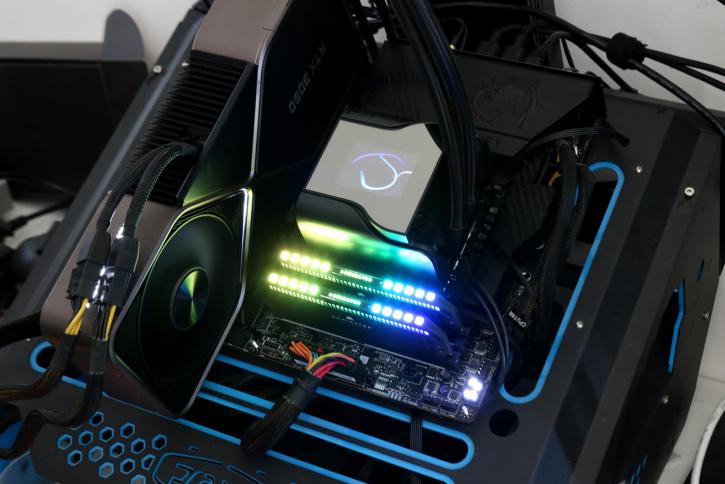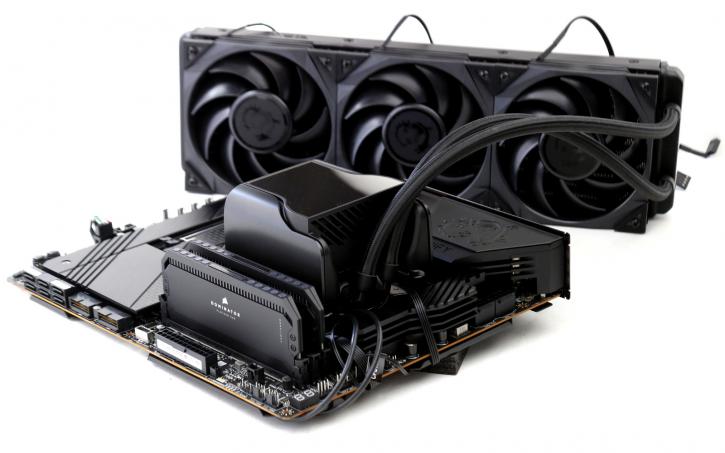Final Words & Conclusion
Final Words
The 12th Generation Intel Core CPUs are now available. Intel has gone a long way, but the new architecture features cores with extremely high performance. An energy-friendly platform, however, isn't. The MSI board is leading the stack of motherboards tested to date. But what a fine motherboard this is. MSI LGA1700 / Z690 boards are available in the MEG, MPG, MAG, and Pro product lines, with solutions from each line. Among them are items that are compatible with both DDR5 and DDR4 memory technologies. The latter was not included in the MEG series, which means that individuals looking to acquire a high-end MSI LGA1700 motherboard will also have to shell out money for a new pair of RAM. Expect to pay 629 EUR/USD for this motherboard which by definition is not much faster than a 200 USD one; however it's all about features.
DDR5 Memory
Memory compatibility should not and likely will not be an issue as long as you stick to QVL supported DIMMs. The sweet spot will be 5200 MHz DDR5 CL40. The more expensive kits will reach CL38. Check out Corsair's, TeamGroup, and G.Skills offering to start with, as they'll have impressive stuff to offer. Nice to see is the new XMP 3.0 profile support. Manufacturers can apply three SPD profiles with more minor changes like latency. Then, the end-user can store another two profiles, so you can tweak that memory and store it directly into the DIMM profiles. Support for this is announced but not yet implemented.
Energy efficiency
With these processors now fabbed at 10nm, you may see some exciting energy efficiency; we expected to drop dead low IDLE energy levels due to the E-cores, but the system comes back at 90 Watts power draw in IDLE. Under total stress on the processors, the system comes back at roughly 375 Watts, and overclocked, we passed 465 Watts. Energy efficiency for this motherboard and processors as such are average at best. Keep that in mind with your cooling choice, as processor wattage usually is 1:1 in line with cooling performance. We recommend an excellent LCS.
Noteworthy is that Intel no longer provides a total design power (TDP), instead referring to a 'processor base power' of 125W and a 'maximum turbo power' that is significantly greater. Intel, at the very least for the overclockable K processors, has ended the confusion that the PL1 and PL2 power constraints produced in previous generations with this announcement. The current norm for these CPUs is that they can boost indefinitely unless the PC maker (or, in the case of self-build, the user) decides otherwise to keep within the limitations of the cooling and power supply systems.
Overclocking
We see the same results on all Z690 motherboards we tested; ergo, the limiting factor is the processor and not the motherboard. Depending on your objectives, there are numerous approaches to overclock an Intel platform. With the Core i9-12900K, you'll achieve roughly 5.3 GHz across all performance cores. And the proc is going to need something like 1.4 Volts. Most modern motherboards will have an automated setting for that. All eight performance cores were overclocked to 5.3 GHz but at the cost of yet another 125W in energy consumption. We gained 5% extra performance due to this. As such, we feel overclocking is a bit unneeded, perhaps even an illogical thing to do. But you can if you want to, and this platform certainly will assist you greatly with it.
The conclusion
The MSI Unify series is distinguished by its solid overclocking potential as well as the entire lack of any RGB illumination, lining up with the Unify philosophy, "less is more." The cardboard box and the delivery scope have been meticulously planned to provide the motivated user with a diverse selection of accessories. In addition to the multiple SATA cables, RGB adapters (if you choose to use them), spacer screws for the numerous M.2 slots, numerous little gimmicks, and a USB stick with the drivers, the box also includes a USB stick with the drivers preloaded on it. The mainboard offers many functions, is completely linear in design, and has five M.2 connection ports hidden beneath the large cooling blocks on the bottom and sides. As a result, you are limited to "just" two PCI Express slots x16 (5.0). In and around the new LGA 1700 socket, you'll stumble into that 19+2 MOSFET structure that is expected to provide 105A of current over each of the Power Stages. Concerning the TDP values of the 16-core top model Core i9-12900K with its 241 watts, this is not surprising, especially when considering the overclocking capabilities of the processor itself. Two P8 power plugs have been provided to ensure that you do not run out of breath while working here. In our belief for lots of people, Alder Lake is what they've been waiting for, a completely new architecture with improved IPC and fabulous overall performance, so lots of people will make the step to upgrade as it also brings PCIe Gen 4.0 and 5.0 as well as DDR5 support and WIFI6E to the table. It has the more muscular VRM setups we've ever seen, and it will undoubtedly prove to be a popular choice among overclockers and enthusiasts seeking extreme performance. Among its many features are four DDR5 DIMMS, which provide the newest memory technology, two PCIe 5.0 lanes for incredibly high-bandwidth expansion cards, and a few future-proofing features. In the end, MSI has a superb offering here; however, the price tag will be a huge bother for most people as it's more expensive than that 12900K we used all by itself. It doesn't make it less impressive, though. And the looks, I do like the all dark design.
- Sign up to receive a notification when we publish a new article
- Or go back to Guru3D's front page.




